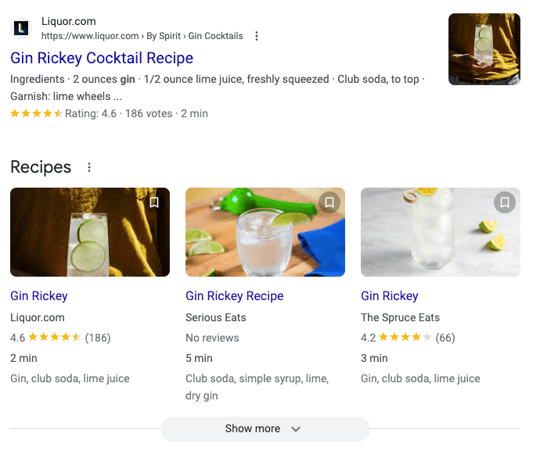Stand Out on the SERPs: Structuring Unstructured Data

On the search engine results page, an enterprise has one chance: one chance to capture the attention of users, one chance to make an impression and one chance to earn a click.
The structure, layout and makeup for most search result pages (SERPs) encountered by average Web users (on a majority of keywords and phrases at least) are, of course, not really that much different from one another. Despite the constant testing on and gradual evolution of SERPs, what most often motivates users to click is still position (70-plus percent of Google clicks in fact occur on the first page).
If a brand can stand out on the increasingly crowded results page, however, a greater volume of traffic can be the reward. So, how exactly is that done? By starting to structure the data presented on Web pages which is likely already being made available by an enterprise.
SAY YES TO THE BENEFITS OF BETTER MARKUP
While there is not any direct evidence that leveraging structured data (and specifically the shared data vocabulary supported by the major search engines via Schema.org) and engaging in such an optimization initiative results in a positive impact on actual search position, digital marketers and SEOs (who for years had postulated otherwise) have learned over time that structuring data enables the search engines to do a better job at crawling their websites - picking up additional context and relevancy cues that can ultimately be added to their sites' listings on the results pages for specific queries (based on the discretion of the search engine).
As seen in the example for the search phrase "Gin Rickey Recipe," not only is an image displayed, but also a rating as well as an indication of the time it will take to make the cocktail.

Structured data markup essentially provides those responsible for search engine optimization a way to showcase a richer and more meaningful listing/result to users, and makes a site eligible to receive a variety of other benefits such as inclusion in voice search, maps and more modern experiences like Google Now. It also enables Google to promote events (and showcase local results too). Google is even piloting a feature that would allow its searchers to play music, watch videos and read critic reviews within search results (as long as the data is marked up appropriately).
For the most part, and in a more practical sense, however, structured data markup helps enterprises showcase content in two important ways: by creating rich snippets (as seen in the Gin Rickey example) and exposing users to customized "Knowledge Graph" information. Since the Knowledge Graph (first introduced in 2012) is such an increasingly important (and interesting) aspect of search engine optimization at Google today, Website Magazine has put together a brief guide to Google's Knowledge Graph to help brands capture additional traffic from the search results.
The focus in this edition of Mastering Search, however, is on creating more compelling listings and standing out on the SERPs to gain more awareness and ultimately more website traffic.
STRUCTURED DATA MECHANICS
It's easy to get overwhelmed with a lot of the terminology associated with structured data. In reality, it's not that complicated (at least from an integration standpoint). The only thing SEOs really need in order to include rich snippets on pages is the addition of some very basic attributes in HTML tags to assign short and descriptive names to various items and properties. The primary elements include itemscope (which indicates the element is a Microdata element and its child elements are part of that format), the itemtype (which defines the vocabulary to be used by the Microdata format), the itemid (the unique identifier of the item), the itemprop (and individual data element) and finally, the itemref (which allows a Microdata element to reference another element on the page).
Those not familiar with coding could easily abandon ship at this point, but most content management systems and ecommerce platforms provide at least some basic functionality to support merchants and publishers who may be interested in a structured data initiative.
Unless a marketer has their digital fingers in their ears, they likely know the official Google stance is that its first priority is to help users find relevant, engaging answers to search queries. Structured data provides just such an opportunity, but Google desn't pull any virtual punches here - indicating that the approach must not create a misleading or deceptive experience for its users, suggesting that it should always be an up-to-date and accurate reflection of the topic and content already found on the page, including text, images and videos.
There are an infinite number of possible use cases. For example, a recipe website could use structured data to list the ingredients and describe the cooking steps. A local business could use structured data to provide a description of the business, the exact location, phone number and hours of operation.
Google, of course, wants to maintain the quality of its search results and so it regularly performs both algorithmic and manual quality checks to ensure structured data meets its existing relevancy standards. If there is a compliance failure on the part of websites, don't be surprised to see Google taking a manual action and disabling rich snippets for that particular site.
DOING DATA RIGHT & WRONG TODAY
Integrating schema markup on Web pages can be challenging - but only for those who do not know what they're doing. Fortunately, many solutions exist that make quick work of structuring previously unstructured data. Get started on your own website by taking advantage of Google's own Structured Data Markup Helper and then check to see if it is compliant with the Structured Data Testing tool.
Make no mistake: structured data will not cure more significant search engine optimization issues. The aim should be to present information to users in a way that is most meaningful and with the right intent, it is relatively easy to make it happen.









